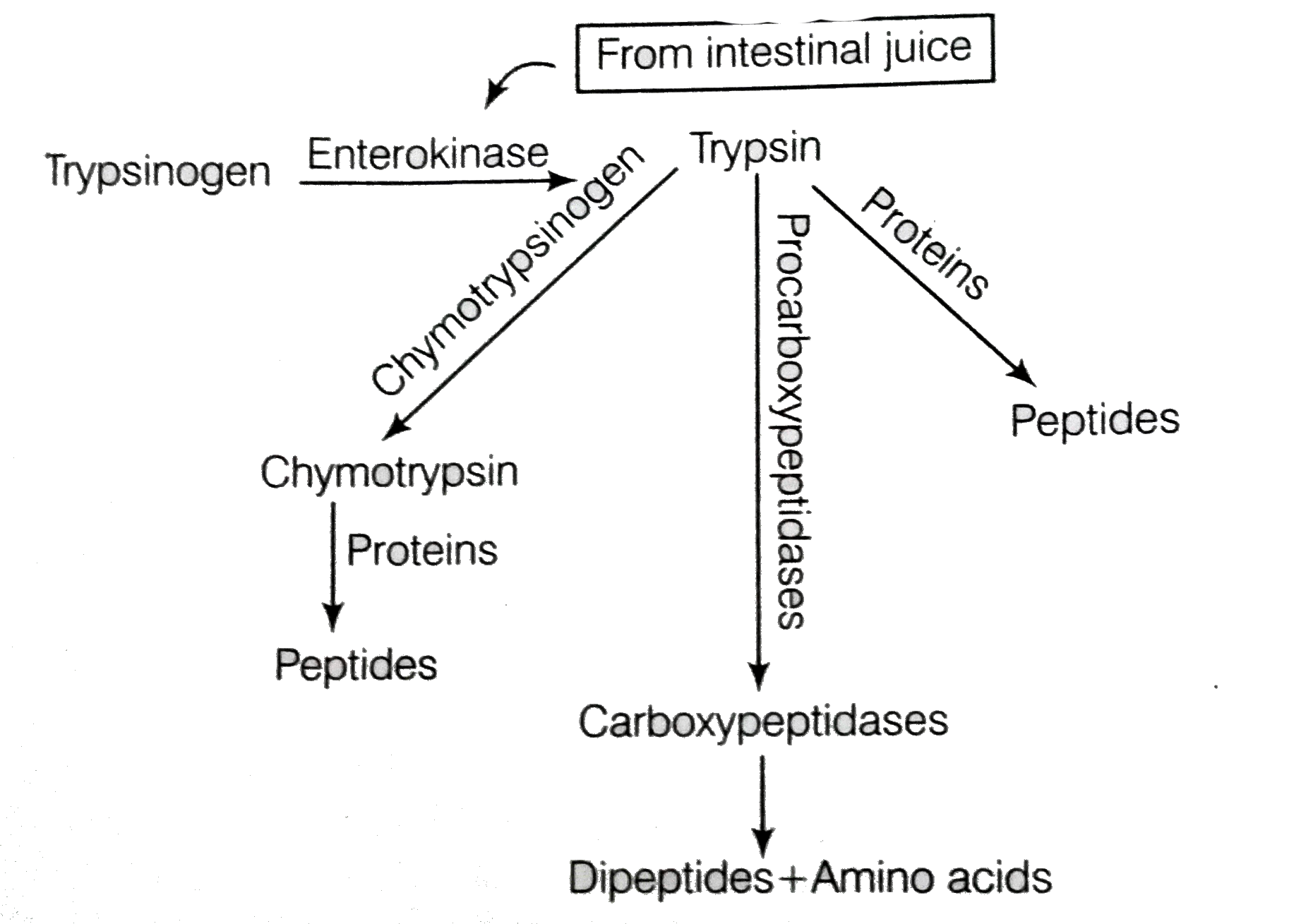(a) Name the main organs of the human digestive system. Also name the associated glands
(b) How do carbohydrates, fats and proteins get digested in human beings ?
Digestion of carbohydrates starts from
Buccal cavity the food receives saliva in the buccal cavity, which contains salivary amylase , It breaks down starch into simple (glucose) suger
Starch and glycogen Amylase−−−−→ Maltose + Isomaltose + Limit dextrins
In small intestine
(i) Pancreatic juice contains pancreatic amylase , which acts in further breakdown the starch.
Starch and glycogen Pancreatic−−−−−→Amylase Maltose + Isomaltose + Limit dextrins
(ii) Intestinal juice contains the following
Intestinal amylase hydrolyses the remaining starch and glycogen.
Maltose Maltase−−−−→ Glucose
Isomaltose Isomaltase−−−−−→ Glucose
Sucrose Sucrase−−−→ Glucose + Fructose
Lactose Lactase−−−→ Glucose + Galactose
Digestion of Proteins starts
In stomach Inactive from of pepsin is secreted known as pepsinogen which on presence of HCl forms pepsin and digests protein,
Pepsinogen + HCl → Pepsin
Proteins " " Pepsin−−−→ Proteoses and peptones
In small intestine
(i) Pancreatic juice secretes Trypsinogen, chymotripsinogen (inactive from of trypsin which an activation forms trypsin and digest protein.

(ii) Intestinal juice
" "Pepptides Aminopeptidases−−−−−−−−−→ Dipeptides + Amino acids
Dipeptides Dipeptidases−−−−−−→ Amino acids
Digestion of Fats begins
In small intestine
(i) Bile emulsifies fats into smaller droplets
(ii) Pancreatic juice present in small intestine acts as follows
" " Treglyceride Lipase−−−→ Fatty acid + lipase
" " Fatty acid + Glycerol Lipase−−−→ Monoglycerides diglyceride
(iii) Intestinal juice acts as
Triglycerides + Diglycerides Intestinal−−−−−→Lipase Fatty acids and glycerol + Monoglycerides
Topper's Solved these Questions
- BOOK - NCERT EXEMPLAR ENGLISHCHAPTER - LIFE PROCESSESEXERCISE - Short Answer Type Questions36videos
LIFE PROCESSES
- BOOK - NCERT EXEMPLAR ENGLISHCHAPTER - HOW DO ORGANISMS REPRODUCEEXERCISE - Long Answer Type Questions10videos
HOW DO ORGANISMS REPRODUCE
- BOOK - NCERT EXEMPLAR ENGLISHCHAPTER - OUR ENVIRONMENTEXERCISE - LONG ANSWER TYPE QUESTIONS8videos
OUR ENVIRONMENT
Similar Questions
Knowledge Check
- Question 1 - Select One
The given figure represents the human digestive system. Identify A,B,C D and E.
 AA-Parotid gland, B-Lvier, C-Pancreas, D-Caecu, E-Vermiform appendixBA-Parotid gland, B-Pancereas, C-Liver, D-Aecum, E-Vermiform appendixCA-Parotid gland, B-Caecum, C-Pancreas, D-Liver, E-Vermiform appendixDA-Parotid galnd, B-Liver. C-Caecu, D-Pancreas,E=Vermiform appendix
AA-Parotid gland, B-Lvier, C-Pancreas, D-Caecu, E-Vermiform appendixBA-Parotid gland, B-Pancereas, C-Liver, D-Aecum, E-Vermiform appendixCA-Parotid gland, B-Caecum, C-Pancreas, D-Liver, E-Vermiform appendixDA-Parotid galnd, B-Liver. C-Caecu, D-Pancreas,E=Vermiform appendix
Name the following:
The organs of digestive system in humans.View SolutionName three different glands associated with the digestive system in humans. Also name their secretions.
View SolutionList of the organs of human alimentry canal and name the major digestive glands with their location.
View SolutionName the following:
The organs of respiratory system in humans.View Solution(a) Name the causative agent of typhoid in humans. (b) Name the test administered to confirm the disease. (c) How does the pathogen gain entry into the human body ? Write the diagnostic symptoms and mention the body organ that gets affected in severe cases.
View SolutionApproximately how much large is whole digestive system in a healthy human ?
View SolutionRead the given statement about the human reproductive system.
(A) The uterus is an inverted pear-shaped organ.
(B) Each testis possesses 150 testicular tubules.
(C) Mammary tubules open into the mammary ducts.
How many of the given statements are incorrect ?View Solution

